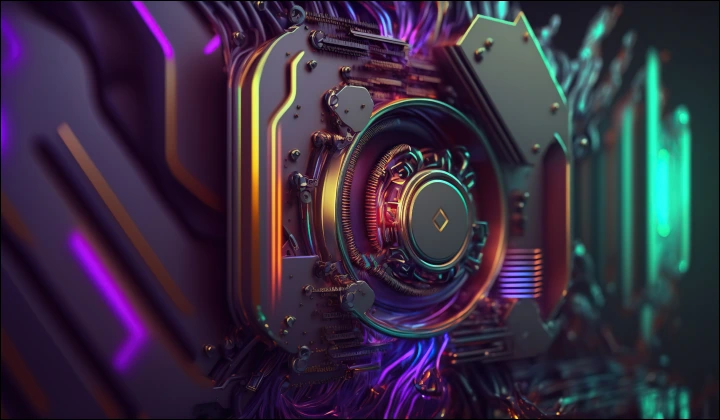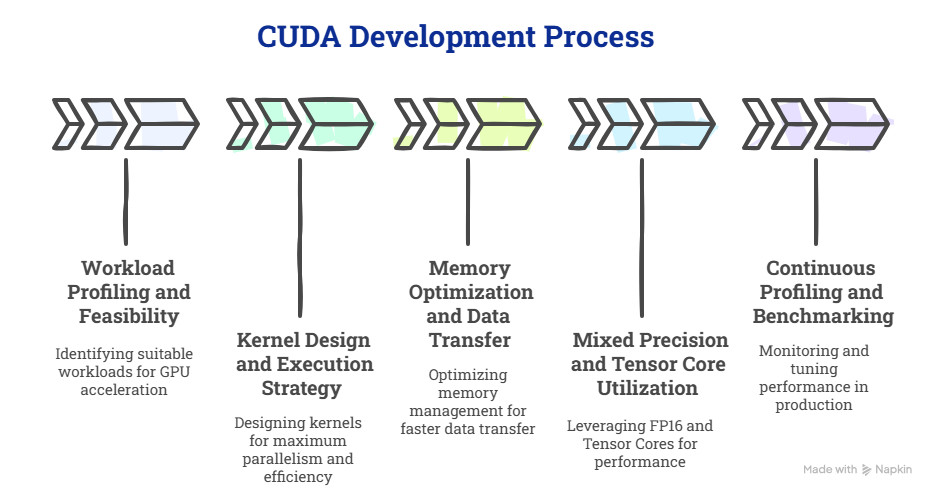 15 mins
15 mins
Dec 02, 2024

When we talk about performance in AI systems, it often comes down to one question: how efficiently can your models process, learn, and adapt in real time?
Over the last few years, NVIDIA’s CUDA has become the backbone of that efficiency. It has quietly simplified how enterprises design, train, and deploy intelligent systems at scale.
At Azilen, our engineering teams use CUDA to push the limits of what’s possible with GPU-accelerated AI. Whether it’s optimizing large-scale inference pipelines or designing high-speed systems, CUDA helps us engineer AI that moves at enterprise speed.
AI models today demand massive parallelism. CPUs, even the best ones, are built for sequential execution, while GPUs excel at performing thousands of simultaneous computations.
CUDA, NVIDIA’s Compute Unified Device Architecture, gives developers the programming framework to harness this parallel power.
For enterprises, this means:
✔️ Faster model training and iteration cycles
✔️ Real-time inference at production scale
✔️ Greater hardware utilization and cost efficiency
✔️ Seamless integration across AI frameworks like PyTorch, TensorFlow, and Triton
CUDA doesn’t just accelerate workloads. It creates a foundation where AI becomes operationally viable and runs smoothly across cloud, on-premise, or hybrid environments.
Building with CUDA involves structuring data, memory, and computation to fully exploit GPU parallelism. Our development approach typically follows this flow:

We begin by identifying the right workloads for GPU acceleration.
Some operations, such as matrix multiplication, convolution, and feature extraction, show massive gains on CUDA cores. Others, like simple data I/O or light transformations, stay on the CPU.
Using tools like Nsight Systems and nvprof, we analyze kernel execution time, memory throughput, and bottlenecks. This helps us define the GPU-to-CPU ratio for each workload early in the design phase.
Once the right workloads are identified, we move into kernel design.
We often start with CUDA C++ kernels tailored for the specific operation. For instance, a custom similarity score computation or a dense matrix operation optimized for coalesced memory access.
Each kernel is structured to maximize thread parallelism, minimize warp divergence, and fully utilize the SMs (Streaming Multiprocessors) of the GPU.
When we build AI models, this translates into:
✔️ Faster forward and backward propagation
✔️ Reduced training time for transformer or CNN-based architectures
✔️ High consistency in inference performance under concurrent loads
We also use CUDA streams to run multiple kernels concurrently, which ensures the GPU never sits idle.
One of the most underrated aspects of NVIDIA CUDA development is memory management. Moving data between the host (CPU) and device (GPU) can be a performance killer if done inefficiently.
Our teams handle this by:
✔️ Allocating pinned (page-locked) memory to speed up host-device transfer
✔️ Using shared memory inside kernels for frequently accessed variables
✔️ Employing asynchronous memory copies to overlap computation with data movement
In high-frequency workloads such as fraud detection or image analytics, these micro-optimizations often lead to double-digit percentage gains in throughput.
For deep learning workloads, we leverage FP16 (half precision) and Tensor Cores to maximize performance without compromising accuracy.
This approach, supported through NVIDIA’s cuDNN and TensorRT, allows us to speed up inference while lowering power and memory consumption.
Enterprises benefit from this directly – faster training loops, smaller infrastructure footprints, and more predictable deployment costs.
Once the system runs in a near-production setup, our engineers benchmark it using NVIDIA Nsight Compute, Triton Metrics, and Prometheus GPU exporters.
We track utilization efficiency, kernel occupancy, memory bandwidth, and latency per inference batch. This helps our AI Ops team continuously tune performance even after deployment.
CUDA is deeply woven into Azilen’s AI engineering framework. It accelerates everything from model development to production-scale inference.
We apply CUDA across four main layers of the AI lifecycle:
Many enterprises begin their CUDA development journey with enthusiasm but encounter hidden complexities when moving to production. Here are the challenges we often address in our projects:
Most performance bottlenecks begin at the kernel level. Custom kernels often run slower than expected because of poor memory access patterns, warp divergence, or excessive synchronization.
At Azilen, we use a profiling-first approach – analyzing occupancy, instruction throughput, and memory bandwidth before kernel optimization.
This lets our engineers refactor kernels for coalesced memory access and shared memory reuse to achieve consistent speedups.
Moving data between CPU and GPU can silently consume up to half of the total runtime. Without pinned memory, asynchronous streams, or proper batching, even well-optimized models underperform.
Our approach incorporates overlapped computation and transfer through streams and events, which ensures the GPU remains continuously active. We also use unified memory for adaptive workloads that require dynamic allocation.
Scaling from one GPU to many introduces complexities, such as device synchronization, data partitioning, and load balancing.
We build CUDA systems that integrate NCCL (NVIDIA Collective Communications Library) for multi-GPU communication, ensuring near-linear scaling for training and inference pipelines.
In hybrid setups, we orchestrate distributed execution using Kubernetes + Triton Inference Server to maintain GPU utilization across clusters.
Enterprises often have established MLOps and cloud stacks built around CPUs. Integrating GPU workloads without disrupting existing workflows can be challenging.
Our engineering teams bridge CUDA with enterprise pipelines using TensorRT, Triton, and MLflow integration layers. This enables organizations to deploy CUDA-accelerated AI without re-architecting their entire environment.
When models scale, tracing GPU utilization or kernel-level performance issues becomes complex.
Azilen uses NVIDIA Nsight Systems and custom telemetry hooks to bring GPU-level visibility into Prometheus and Grafana dashboards.
This helps enterprise teams monitor GPU performance alongside application metrics, which closes the gap between development and operations.
CUDA’s learning curve is steep, and maintaining custom kernels requires specialized skills.
We often support enterprises through a co-engineering model, where Azilen’s AI experts work alongside in-house teams to provide architectural guidance, performance benchmarking, and reusable code modules.
Some enterprises hesitate to adopt CUDA deeply due to fears of being tied to specific GPU hardware or SDK versions.
We help mitigate that through modular architecture design by building abstraction layers that allow selective offloading to CUDA, ROCm, or even CPU fallback paths when needed. This future-proofs AI systems against rapid hardware evolution.
Performance in AI is no longer about raw speed; it’s about return on computation. CUDA brings measurable advantages:
✔️ Up to 20x faster model training compared to CPU-only systems
✔️ 40–60% reduction in inference latency for production workloads
✔️ Optimized hardware utilization, reducing total cloud GPU spend
These outcomes compound over time. Faster iterations mean faster innovation. Efficient GPU usage means better margins.
The result? Enterprises can bring AI products to market faster while keeping infrastructure costs under control.
Not at all. Most modern AI frameworks like TensorFlow and PyTorch already come with CUDA support. What we do at Azilen is go a step deeper: we customize kernels, memory management, and execution patterns to squeeze maximum performance out of your specific workload.
Deep learning benefits the most, yes, but CUDA is useful anywhere you need parallel computation. That includes fraud analytics, IoT data processing, simulation engines, or even recommendation systems. We’ve used CUDA in all these scenarios to speed things up dramatically.
Renting GPUs gives you the hardware. CUDA makes that hardware work efficiently. Without optimized CUDA development, you’re essentially paying for power you’re not fully using. Our role is to make sure every GPU cycle counts toward faster insights or smoother performance.
Absolutely. Many enterprises come to us with systems already on GPU but not performing as expected. We profile the workloads, identify inefficiencies, and re-engineer kernels or data pipelines with CUDA best practices. The difference in performance is often huge.
Start with a discovery session. We’ll look at your current AI pipeline, identify where GPU acceleration makes sense, and design a proof of concept that shows measurable gains. From there, we build your roadmap to full-scale CUDA adoption.
1️⃣ CUDA (Compute Unified Device Architecture): A parallel computing platform and programming model developed by NVIDIA that enables developers to use GPUs for general-purpose processing.
2️⃣ GPU (Graphics Processing Unit): A specialized processor designed for parallel computation. GPUs handle multiple operations simultaneously, making them ideal for AI, deep learning, and data-intensive workloads.
3️⃣ Kernel: A function written in CUDA that runs on the GPU. It defines the operations each GPU thread performs in parallel.
4️⃣ Parallel Computing: A computational method where multiple processes run simultaneously to accelerate complex calculations.
5️⃣ cuDNN (CUDA Deep Neural Network Library): A GPU-accelerated library by NVIDIA that provides optimized primitives for deep neural networks such as convolution and pooling operations.
6️⃣ cuBLAS: A CUDA-based library implementing BLAS (Basic Linear Algebra Subprograms) operations for efficient matrix computations on GPUs.